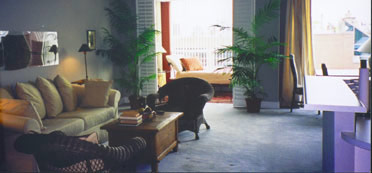Avoid In Interior Decoration

|E all know the saying that it is only those who have mastered the steps in dancing who can afford to forget them. It is the same in every art. Therefore let us state at once, that all rules may be broken by the educated the masters of their respective arts. For beginners we give the following rules as a guide, until they get their bearings in this fascinating game of making pictures by manipulating lines and colors, as expressed in necessary furnishings.
Avoid crowding your rooms, walls or tables, for in creating a home one must produce the quality of restfulness by order and space.
As to walls, do not use a cold color in a north or shaded room. Make your ceilings lighter in tone than the sidewalls, using a very pale shade of the same color as the sidewalls.
Do not put a spotted (figured) surface on other spotted (figured) surfaces. A plain wallpaper is the proper, because most effective, background for pictures. Avoid the mistake of forgetting that table decoration includes all china, glass, silver and linen used in serving any meal. In attempting the decoration of your dining-room table avoid anything inappropriate to the particular meal to be served and the scale of service. Do not have too many flowers on your table, or flowers not in harmony with the rest of the setting, in variety or color. Do not use peasant china, no matter how decorative in itself, on fine damask or rare lace. By so doing you strike a false note. The background it demands is crash or peasant lace. Avoid crowding your dining table or giving it an air of confusion by the number of things on it, thus destroying the laws of simplicity, line and balance in decoration.
Avoid using on your walls as mere decorations articles such as rugs or priests' vestments primarily intended for other purposes. Avoid the misuse of anything in furnishing. It needs only knowledge and patience to find the correct thing for each need. Better do without than employ a makeshift in decorating. Inappropriateness and elaboration can defeat artistic beauty but intelligent elimination never can beware of having about too many vases, or china meant for domestic use. The proper place for table china, no matter how rare it is, is in the dining room. If very valuable, one can keep it in cabinets. Useless bric-a-brac in a dining room looks worse than it does anywhere else.
Your dining room is the best place for any brasses, copper or pewter you may own. If sitting room and dining-room connect by a wide opening, keep the same color scheme in both, or, in any case, the same depth of color. This gives an effect of space. It is not uncommon when a house is very small, to keep all of the walls and woodwork, and all of the carpets, in exactly the same color and tone. If variety in the color-scheme is desired, it may be introduced by means of cretonnes or silks used for hangings and furniture covers.
Avoid the use of thin, old silks on sofas or chair seats. Avoid too cheap materials for curtains or chair covers, as they will surely fade. Avoid too many small rugs in a room. This gives an impression of restless disorder and interferes with the architect's lines.
Do not place your rugs at strange angles; but let them follow the lines of the walls. Avoid placing ornaments or photographs on a piano, which is in sufficiently good condition to be used. Avoid the chance of ludicrous effects. For example, keep a plain background behind your piano. Make sure that, when listening to music you are not distracted by seeing a bewildering section of a picture above the pianist's head, or a silly little vase dodging, as he moves, in front of, above, or below his nose! Avoid placing vases, or a clock, against a chimneypiece already elaborately decorated by the architect, as a part of his scheme in using the moulding of panel to frame a painting over the mantel. In the old palaces one sees that a bit of undecorated background is provided between mantel and the architect's decoration. If your room has a long wall space, furnish it with a large cabinet or console, or a sofa and two chairs.
Avoid blotting out your architect's cleverest points by thoughtlessly misplacing hangings. Whoever decorates should always keep the architect's intention in mind. Avoid having an antique clock, which does not go, and is used merely as an ornament. Make your rooms alive by having all the clocks running. This is one of the subtleties, which marks the difference between an antique shop, or museum, and a home.
Avoid the desecration of the few good antiques you own, by the use of a too modern color scheme. Have the necessary modern pieces you have bought to supplement your treasures, stained or painted a dull dark color in harmony with the antiques, and then use dull colors in the floor coverings, curtains and cushions.
If you have no good old ornaments, try to get a few good shapes and colors in inexpensive reproductions of the period to which your antiques belong. Avoid the mistake of forgetting that every room is a "stage setting," and must be a becoming and harmonious background for its OCCUT pants.
Avoid arranging a Louis XVI bedroom, with fragile antiques and delicate tones, for your husband of athletic proportions and elemental tastes. He will not only feel, but also look out of place. If he happens to be fond of artistic things, give him these in durable shades and shapes. Avoid the omission of a thoroughly masculine sitting room, library, smoking-room or billiard-room for the man, or men, of the house.
